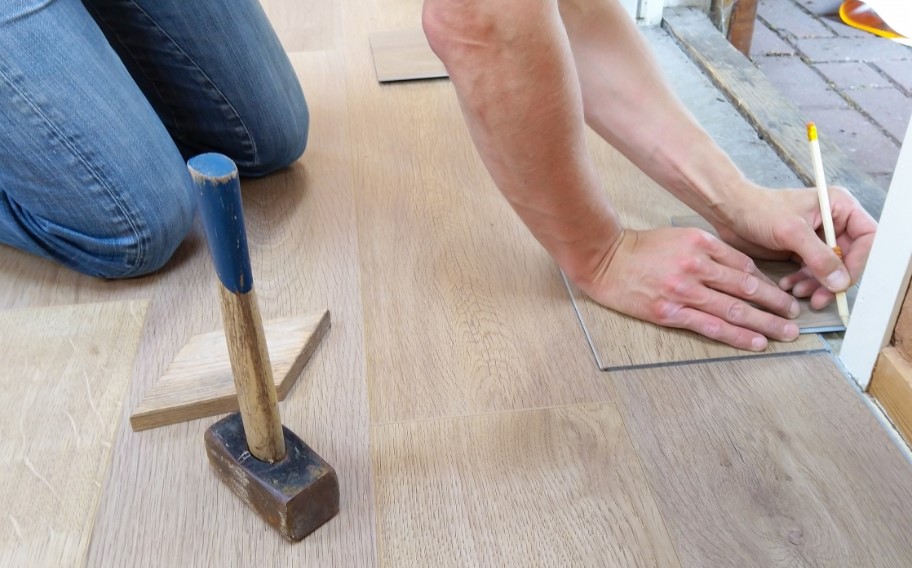Laminate flooring
Contents |
[edit] Introduction
The term ‘flooring’ refers to the lower enclosing surface of spaces within buildings. This may be part of the floor structure, such as the upper surface of a concrete slab or floor boards, but typically it is a permanent covering laid over the floor. There are many types of flooring materials available. For more information see Types of flooring.
[edit] What is laminate flooring?
Laminate flooring is a synthetic flooring product made from multiple layers. Modern click and lock laminate floors 'float' - in that they are not fixed to the layer underneath.
While there are many different laminate flooring manufacturing methods, they are generally based on variations of a similar composition:
- The top layer is a moisture resistant (but not waterproof), high resolution photographic image of a natural material - such as wood or stone. This layer is coated with a clear, protective (and sometimes scratch resistant) finish that prevents the image from fading with age or from exposure to sunlight.
- Below that is a core made from compressed fibreboard designed to stabilise the product.
- The bottom layer, which is often the same thickness as the core, is made from melamine resin. Its purpose is to add moisture resistance and noise absorption. It also strengthens the flooring and can help even out minor imperfections in the subfloor.
BS EN 13329 sets out the specification requirements for laminate flooring.
[edit] History of laminates
Laminate flooring has been on the market since the 1970s. The Swedish Chemical Company Perstorp AB Holdings is credited with inventing laminate flooring in 1977. The team was given the task of modifying laminate kitchen countertops for use as flooring materials. The resulting product was launched in Sweden under the name Perstorp Golv GL80 in 1980. It was introduced to European markets in 1984 as 'Pergo' and taken to North America in 1994.
Early iterations of laminate flooring were often considered inferior to real wood due to poor printing quality and manufacturing processes. Glue-based installation methods sometimes resulted in buckled surfaces.
Over time, printing technology and installation improved. Current laminate flooring products can include realistic bevels, grooves and embossed surface textures to make them look and feel more authentic. A glueless click and lock method was introduced in 1996.
Laminate flooring products are now available in a wide range of patterns, textures, widths, lengths and thicknesses.
[edit] Installation
Based on the click and lock method, installation of laminate flooring is fairly simple and a professional contractor may not be required.
An important part of the installation process is the preparation of the flooring surface. While it may or may not be necessary to remove old flooring, a suitable underlay should always be used. Since this installation method creates a floating surface, it is possible to put one floor on top of another, with underlay in between, as long as the surface is clean, flat and dry.
Under the right conditions, a laminate floor may be installed over the following surfaces:
- Concrete slab.
- Cork.
- Hardwood (but not engineered wood).
- Linoleum.
- Natural stone (if smooth).
- Oriented Strand Board (OSB) or particleboard.
- Plywood.
- Porcelain tile.
- Vinyl tiles, sheets or planks.
Before installation, materials should be given time to acclimatise to their environment. The unopened boxes can sit for 48 hours or more at normal room temperature to give them time to adjust.
Next, it may be beneficial to arrange the laminate materials on the floor as a mock up before installing them. While the click and lock method isn’t permanent, this planning step helps to anticipate cuts and adjustments created by the shape of the room or difficult areas around doors.
It is important to leave slight gaps between the floor and the wall for expansion once the boards are locked in place.
[edit] Durability
Laminate flooring is rated for its durability based on an Abrasion Criteria (AC) system. On a scale from one to five, these ratings measure wear resistance and help determine the suitability of products for different applications:
- AC1—moderate domestic applications
- AC2—general domestic applications
- AC3—heavy domestic applications or moderate commercial traffic
- AC4—general commercial traffic
- AC5—heavy commercial applications
High quality laminates may have a 20-year warranty.
[edit] Maintenance
Laminate floors require minimal maintenance and may be installed with underfloor heating. However, underfloor heating should be increased gradually over a period of several days during its first use or after long periods when it has been turned off.
Cleaning simply requires sweeping, although more serious stains can be treated with wood floor cleaner and a damp mop. Water should not be left standing on laminate flooring surfaces.
It is not possible to sand or refinish laminate floors if they become damaged or worn.
Many laminate floors are recyclable and can be reprocessed into other products. Old laminate floors should not be incinerated, due to the chemicals that are part of the manufacturing process.
[edit] Related articles on Designing Buildings
- Ash or oak wood flooring.
- BREEAM Speculative floor & ceiling finishes.
- Click and lock flooring.
- Concrete floor.
- Cork flooring.
- Domestic floors: Part 1: Construction, insulation and damp proofing.
- Floating floor.
- Flooring defects.
- Laminate.
- Subfloor.
- The Differences Between Engineered Flooring and Solid Hardwood Flooring.
- Types of floor.
- Types of flooring.
- Underfloor heating.
Featured articles and news
The Building Safety Forum at the Installershow 2025
With speakers confirmed for 24 June as part of Building Safety Week.
The UK’s largest air pollution campaign.
Future Homes Standard, now includes solar, but what else?
Will the new standard, due to in the Autumn, go far enough in terms of performance ?
BSRIA Briefing: Cleaner Air, Better tomorrow
A look back at issues relating to inside and outside air quality, discussed during the BSRIA briefing in 2023.
Restoring Abbotsford's hothouse
Bringing the writer Walter Scott's garden to life.
Reflections on the spending review with CIAT.
Retired firefighter cycles world to raise Grenfell funds
Leaving on 14 June 2025 Stephen will raise money for youth and schools through the Grenfell Foundation.
Key points for construction at a glance with industry reactions.
Functionality, visibility and sustainability
The simpler approach to specification.
Architects, architecture, buildings, and inspiration in film
The close ties between makers and the movies, with our long list of suggested viewing.
SELECT three-point plan for action issued to MSPs
Call for Scottish regulation, green skills and recognition of electrotechnical industry as part of a manifesto for Scottish Parliamentary elections.
UCEM becomes the University of the Built Environment
Major milestone in its 106-year history, follows recent merger with London School of Architecture (LSE).
Professional practical experience for Architects in training
The long process to transform the nature of education and professional practical experience in the Architecture profession following recent reports.
A people-first approach to retrofit
Moving away from the destructive paradigm of fabric-first.
International Electrician Day, 10 June 2025
Celebrating the role of electrical engineers from André-Marie Amperè, today and for the future.
New guide for clients launched at Houses of Parliament
'There has never been a more important time for clients to step up and ...ask the right questions'
The impact of recycled slate tiles
Innovation across the decades.
EPC changes for existing buildings
Changes and their context as the new RdSAP methodology comes into use from 15 June.


























